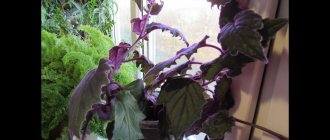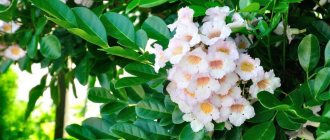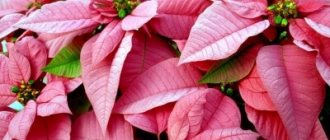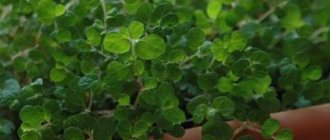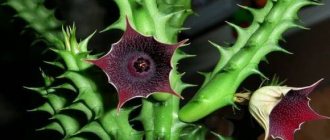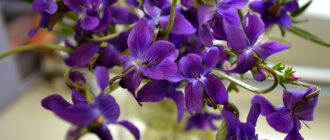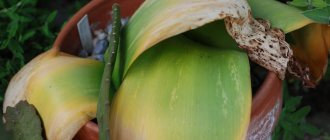Origin of clusia
Clusia originated from the Caribbean region of Florida. There the culture has the largest population. Gradually, the plant spread to other tropical countries, then varieties were developed for growing at home.
Flower with red center
Clusia received its name in honor of the 16th century botanist Charles Clusius. At that time he was one of the most famous botanists. It was proclaimed this way by Charles Plumier, a French scientist who studied the flower.
Description of the plant
Neomarica walking iris: home care and examples of popular varieties
A heterosexual evergreen plant. It looks like a low tree or shrub; there are a large number of green leaves on the branches. They have a dense fleshy structure and are covered with a waxy coating. The leaves are round, dark green in color.
The flower has a well-developed root system. The older the tree, the more it grows. More mature shoots gradually become covered with bark. The plant needs a large area. Only one variety is grown at home - Clusia Rosea.
Flower in a pot
Flowering occurs all year round. The buds bloom at night and remain in this state for 10 hours. As dawn approaches, the petals close until the next night. At least 10 buds are formed on each branch.
The flowers are light pink or bright pink. The diameter of the inflorescence is 5 cm. There is a yellow core inside, which leaves stains on the fingers when touched. After flowering is complete, capsule-shaped fruits are formed. They are poisonous. It is prohibited to eat them.
Interesting. Previously, during the construction of ships, clusia juice was used to hold the boards together. It has a resinous structure and at that time served as an adhesive.
Types and varieties
The Clusium family includes more than 300 species. The type of clusia itself includes at least 150 varieties. Many of them grow in the natural environment. Some varieties have been adapted for growing indoors.
Clusia Pink Princess
Stephanotis - home care
Clusia Rosea princess is the most popular plant variety. It can often be found among flower growers. The flower looks like a small tree with dense, fleshy leaves. There are a large number of them on each branch. Flowering occurs constantly, white or pink flowers are formed, consisting of 8-10 petals. They are covered with a dense waxy layer. The buds open at night and close during the day. After flowering, a fruit capsule is formed.
Clusia variegata
A small tree-like plant. Covered with green fleshy leaves with yellow stripes. In its natural environment it reaches more than 1 m in height. Flowering occurs all year round. Clusia variegata produces beautiful pink flowers, 8 cm in diameter. They consist of 6-8 petals.
Important! The juice of the plant can cause irritation and redness of the skin, so it is recommended to wear gloves when working with it.
Description of flowering and reproduction
Fittonia home care, cultivation and reproduction
Clusia can grow in the soil, but more often it is an epiphyte. Birds disperse seeds through the air. Once on the plant, the seeds take off aerial roots, which grow and grow into the soil. The roots of clusia begin to branch abundantly, which leads to the appearance of crossed plants.
Clusia has leathery leaves on short petioles, distributed alternately on the stem. Bright green leaves, depending on the species, can grow from 5 to 20 centimeters. The leaves contain sticky juice that irritates the skin.
The clusia flower opens at night and closes in the morning. The bud can have from 4 to 9 waxy petals, pale in color. They grow 4-5 centimeters in diameter. After going through the pollination process, a fruit appears that looks like a poppy box covered with a green shell. When ripe, a star-shaped flower appears, inside which contains seeds covered with red pulp.
Transplanting clusia after purchase into a pot
Medinilla flower: home care and propagation methods
The flower undergoes transplantation to a new place quite painfully. Therefore, you need to be extremely careful during the procedure. It is recommended to carry out the procedure only when the plant stops growing in the old pot.
If, when purchasing, the pot is the optimal size and the plant is still small, then replanting is not necessary. If, on the contrary, the flower is large and the container is small, then it is better to replant it.
What is needed for planting
To carry out a transplant, you must prepare the necessary materials in advance:
- the pot is larger than the previous one;
- drainage mixture in the form of pebbles, sand, coconut bark;
- soil mixture of peat, vermiculite and sand;
- rubber gloves;
- knife;
- water.
Clusia with headband
Fresh soil is chosen for planting. You can purchase the finished composition in specialized stores. The bag should be marked “For flowering plants.” If the grower decides to prepare it himself, then all the components (peat, vermiculite and sand) are mixed in equal parts, then calcined in the oven for 20 minutes. at 100 °C.
Optimal place
A wide table is suitable for the procedure; in the summer, a balcony or floor. It is advisable to choose a place out of direct sunlight.
Clusia flower white-pink
After transplantation, the flower is placed in a shaded place for 4 weeks.
Step by step planting process
The transplantation process is carried out step by step, following all the rules:
- Put on gloves.
- 1/3 of the drainage is placed in a new container.
- A knife is drawn along the contour of the old pot to make it easier to remove the plant.
- Carefully remove the flower from the pot, holding it by the trunk.
- Transfer to a new pot without clearing the soil.
- Sprinkle with soil, filling all gaps with air.
- Water the plant.
Protect the flower from direct sunlight for 6 weeks. During this time, pink clusia must get used to the new growing conditions.
Pests and diseases of clusus
Diseases and their treatment
Clusia rarely gets sick, but sometimes it can get into trouble due to improper living conditions or errors in care. For example, insufficient lighting can cause clusia leaves to begin to turn yellow and fall off, and from chronic waterlogging, a fungal coating appears on the leaves of the plant, which, spreading, leads to rotting.
If you find signs of a fungal infection developing on ground organs, remove the flower from the pot, remove rotting areas with a sharp sterile instrument, capturing some healthy tissue, replant the plant in a fresh substrate and review the watering regime.
- Conditions for growing eustoma at home
Pests and their control
Pests that can attack clusus are scale insects, mealybugs and spider mites. All these parasites make bites in the leaves of the plant and feed on its sap, causing the clusia to wither and its leaves and young shoots to become deformed.
If scale insects and scale insects are found, you need to remove them from the leaves using a cotton swab dipped in alcohol or soap solution, after which the plant is washed with soap in the shower, protecting the substrate with a film from water and soap getting into it. The plant is allowed to dry and the leaves are treated with an insecticide solution.
In the photo: Clusia flower
Spider mites are very small arachnids that settle on the underside of leaves and weave very thin webs. You can recognize their presence by small discolored dots on the leaves - places where they have been bitten. Washing the clusia in the shower should scare away pests that love dryness and heat, but if the mites have time to multiply, washing alone will not eliminate the problem: you will have to resort to treating the plant with acaricidal preparations.
Clusia care
Clusia care at home does not take much effort. This flower will delight you with its blooming, especially in the evening, and will bring tropical notes to the interior of the room.
Clusia with pale pink color
Watering mode
The culture does not tolerate waterlogging very well. Since its homeland is the tropics, the flower has high resistance to heat. This is due to the well-developed root system, as well as the fleshy structure of the leaves, in which water accumulates.
The plant is watered as the soil dries out. This is checked by the top layer of soil; it should be completely dry. There are also special measuring instruments for this.
Important! You cannot overwater Rosea princesses - this will lead to rot in the roots and death.
Top dressing
The process of fertilizing a clusia plant has several features. This should be taken into account when caring for:
- feed every two weeks in summer and once a month in winter;
- For this purpose, mineral complexes for flowering crops are used;
- Liquid solutions of chicken manure or mullein in a 5% concentration are also suitable;
- Watering is combined with fertilizing, so the flower will quickly absorb nutrients.
They fertilize the plant to improve flowering, strengthen the immune system, and protect against attacks by harmful insects and infections.
During the flowering period
During flowering, the plant needs to create optimal conditions for growth. Follow a few simple rules:
- Clusia is a light-loving plant. Therefore, place the pot in a well-lit place, but protected from direct sunlight. In winter, it is recommended to illuminate the flower up to 12 hours a day.
Clusia in a pot without flowers
- The plant does well in indoor conditions. The optimal temperature is 25°C.
- It is advisable to regularly ventilate the room, but do not place the pot in a draft.
- Clusia loves high air humidity, so it is recommended to periodically spray the foliage with settled water from a spray bottle.
During the rest period
The plant's dormant period begins from late autumn to the end of winter. This usually takes about 3-4 months. Then the plant begins to produce flowers again and delight gardeners. During dormancy, watering is limited or stopped completely. Move the pot to a shaded place. It is also not recommended to feed the indoor clusia flower. Typically apply a small amount of fertilizer once a month.
Important! During dormancy, the plant can be left in the same place, but protected from the sun with a sheet of paper.
Preparing for winter
The plant needs to be prepared for winter. The dormant period is indicated by the last fruit to ripen on the branch: it opens and then falls. Clusia is prepared as follows:
- all old, yellow and damaged leaves and shoots are removed;
- remove dry fruits from the branches;
- water the flower before wintering;
- apply fertilizer once;
- transferred to a more shaded place;
- The room temperature is maintained at about 20°C.
Clusia rosea is popular with gardeners who prefer tropical plants. Rosea will brighten up any home with its beautiful pink and white flowers. The culture is unpretentious in care, does not require special attention, is heat-resistant, and therefore does not require constant watering.
In its natural environment, the flower has the shape of a small tree or bush. And at home we learned how to maintain clusus and get full flowering. Taking care of her is a pleasure.
Home care
Clusia is best purchased in the spring. After the purchase, it is advisable to provide certain conditions for the clusia, where it will grow and develop.
Illumination
Clusia, like most house flowers, needs light.
An important condition is that the light must be diffused. It is recommended to place the plant on windowsills, east or west side
In winter, it is advisable to provide illumination for the flower with a phytolamp.
Temperature and humidity
In the warm season, the favorable temperature is +25, in winter +20 is acceptable. Avoid drafts, but try to ventilate the room periodically.
Requires high humidity. Periodically you need to spray the plant with water at room temperature and wipe the leaves with a damp cloth.
Watering
Water for irrigation should be warm. Watering should be done once a week, or as the top layer of soil dries out.
It is important to avoid excess moisture, which can lead to the death of the plant.
Top dressing
Fertilizing is used in warm weather (April - October) 2 times a month, in winter - 1 time a month. These are complex fertilizers, from which half the portion of the recommended dose is taken.
Pruning has a beneficial effect on the plant and helps it stimulate branching of the stems.
Transfer
A painful procedure for this plant. It should be carried out only when absolutely necessary and subject to certain rules.
It is better to replant in the spring, using the transshipment method. The pot should be a couple of centimeters larger than the root system. Place 4 cm of drainage at the bottom, and without shaking off the soil from the roots, replant the plant. For several days, spray with warm water.
What kind of pot do you need?
A wide, shallow ceramic pot is best suited, and be sure to match the size of the roots.
Priming
The soil must have good moisture and breathability, containing acidity. You can get the ideal soil by mixing coniferous and leaf soil, vermiculite, peat and sand.
Reproduction
There are 3 methods of reproduction:
- cuttings;
- layering;
- seeds.
Apical cuttings are harvested in spring. The cuttings are pre-treated with growth stimulants. Then they are placed in a warm place where the soil and temperature are 25 degrees. A mini-greenhouse is suitable for this, covering the cuttings with film or glass. Rooting occurs in 3-4 weeks.
Mature plants have aerial roots, which grow over time and form shoots. These branches can be grown as individual plants.
Propagation by seeds is more difficult than the previous two. The fact is that the seeds quickly lose their viability.
The seeds are soaked in a special solution to grow on a flat surface. Then the pot is filled with a mixture of sand and peat, moistened and the seeds are lowered to half the depth. Cover with film or glass and place in a warm place with soft light.
Diseases and pests
Proper care of clusus guarantees a minimal risk of disease and infection. It is necessary to monitor the temperature in the room with the flower and not overwater. The most dangerous pests are mealybugs and spider mites.
